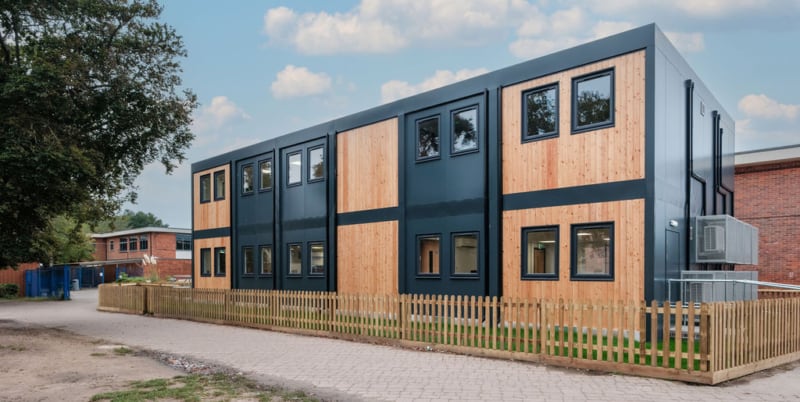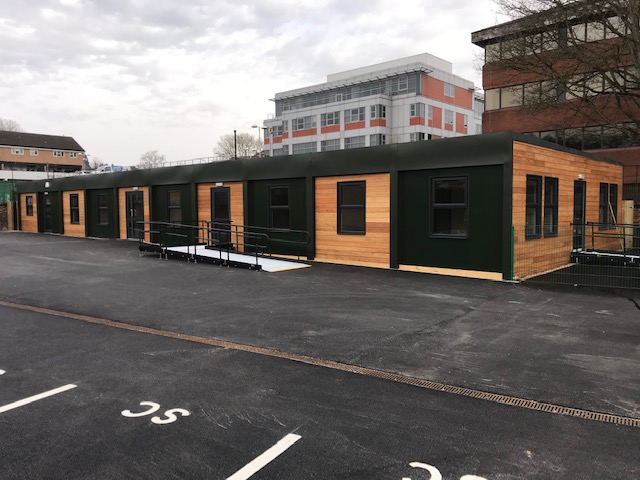18.12.2023• Modular Buildings, Posts & News
How can Modular Buildings offer pupils a brighter future?

In recent years, the education sector has undergone significant changes and schools have had to adapt quickly to keep up. Education establishments must respond to changes within their areas to provide up-to-date facilities for their students and staff. Whether they are looking to update provisions or expand to handle fluctuating student populations, modular school buildings can provide the answer they are looking for.
Modular classrooms respond to the needs of students.
When planning new classroom space, it is important to understand the needs of students to ensure that they receive the very best education possible. The environment we provide students is almost as important as the education itself.
So what factors should we take into consideration, and how can modular school buildings help?
Natural light and ventilation
When planning a new classroom, natural light will play a huge part in helping concentration and energy levels among both students and teachers. Exposure to daylight has been linked to improved mood, focus and overall well-being.
Also, ensure that you allow for proper ventilation to create a comfortable and healthy environment. Fresh air contributes to increased alertness and concentration. Having windows that open safely and easily is essential. However, appropriate air conditioning is vital when that is not possible due to cold weather or other factors.
Modular buildings are designed to let in as much natural light as possible, with the latest in double-glazing windows for comfort. They also come fitted with comfortable and easy-to-use HVAC systems.
Flexible and adaptable spaces
Use flexible furniture solutions that can be easily rearranged to accommodate various learning activities. Being able to move furniture around keeps your classroom adaptable. This allows for collaboration, group work and individual study sessions.
Plan for spaces that can be used for multiple purposes, encouraging dynamic and adaptable learning environments. This helps keep students engaged so they do not become stagnant in their classes. However, it also helps your establishment to remain flexible enough to plan and move lessons when needed.
Modular buildings are incredibly flexible by nature. Your organisation can design your spaces to be as flexible as you need them to be. You are involved in the design and planning of your bespoke building.
Technology integration
Schools have changed a lot over the years. Blackboards are a thing of the past, so schools must ensure they have access to the latest equipment. Incorporate interactive displays and smart boards to facilitate engaging and interactive lessons. Technology should enhance the learning experience and encourage student participation.
Also, ensure that students have access to digital devices and a reliable internet connection for research, collaboration and accessing educational resources.
Modular buildings can be supplied with the latest AV technology, including smart boards. They can be fitted with Wi-Fi and plenty of data ports to ensure everyone stays connected. You can also ensure that you have enough secure storage to protect any expensive equipment.
Design and aesthetics
The space we work in has a massive effect on our productivity. Use a combination of vibrant and calming colours to create a stimulating yet comfortable atmosphere. Different colours can impact mood and stimulate creativity. Think carefully about what your space is to be used for. Study areas might benefit from calmer colours, whereas brighter colours will be helpful in creative spaces.
Also, ensure that spaces are suitable for everyone who needs to use them. Think about accessibility and plan for ramps and lifts for users with physical disabilities. Modular buildings give you the flexibility to consider what is needed for all the users of your space.

Access to green spaces and nature
The presence of greenery has been shown to reduce stress and improve feelings of well-being. Introduce indoor plants to improve air quality and create a connection to nature.
Design outdoor areas where students can learn and engage with nature if possible. For older students, having outdoor areas for study can improve concentration, weather permitting. Outdoor spaces provide a change of scenery and promote physical activity.
Modular buildings are flexible enough to be planned with plenty of outdoor space around them, depending on your environment. You can consider your outdoor landscaping to incorporate learning areas, vegetable patches or spaces to relax and take it all in.
Collaborative learning
Collaboration encourages discussion, which leads to elevated learning. It helps develop a higher level of thinking, oral communication and promotes self-management and leadership skills. Group work promotes interpersonal skills, giving students skills outside of the actual task at hand. Designate areas for group discussions and collaborative projects. You can create a sense of teamwork and communication by designing spaces that encourage interaction.
Provide areas for breakout zones or quiet corners where students can work independently or in small groups. This is also important for students who may have neurodivergent needs.
Flexible and adaptable spaces help facilitate group work and modular buildings are great for this. You can create open-plan areas and use easily movable partitions to make the space as flexible as possible.

Modular School Buildings for everyone
PF Modular have been supplying modular buildings for the education sector since 2005. Our dedicated team helps schools, colleges and universities to provide inspirational learning spaces for students around the UK.
Modular classrooms are cost-effective, fast and eco-friendly while providing a truly flexible solution for educational needs. A modular building can be installed in a short space of time. This means you can have a new building ready during the school holidays, mitigating any disruption to the running of your school.
Our design team can help you to ensure that your modular classroom building is designed to accommodate everyone who uses it. We use our years of extensive experience providing modular buildings and mobile classrooms to help you make the most of your new building.
We’ll also help you make the most of tight education budgets. We can ensure you have all the space you need at a fraction of the cost of a traditional construction.
Speak to a member of our team to get your new classroom ready for a new term.
Related Posts

27.11.2024• Modular Buildings, Posts & News
Why Modular Changing Facilities Are Perfect for Schools and Sports Clubs
Schools and sports clubs need the right facilities to create an environment where students and athletes can perform at their best. Modular buildings are...
Continue Reading
27.11.2024• Modular Buildings, Posts & News
How Second-Hand Modular Buildings Offer Cost-Effective and Fast Solutions
Companies need to have the ability to adapt to the changing demands of their business. Whether it’s expanding operations, relocating or setting up a...
Continue Reading
31.10.2024• Modular Buildings
How Modular School Buildings Support Modern Teaching Methods
As teaching methods evolve to meet the needs of today’s students, schools require flexible, adaptive spaces to support innovative learning experiences. However, traditional classrooms...
Continue Reading